
The Aromanians are an ethnic group native to the southern Balkans who speak Aromanian, an Eastern Romance language. They traditionally live in central and southern Albania, south-western Bulgaria, northern and central Greece and North Macedonia, and can currently be found in central and southern Albania, south-western Bulgaria, south-western and eastern North Macedonia, northern and central Greece, southern Serbia and south-eastern Romania. An Aromanian diaspora living outside these places also exists. The Aromanians are known by several other names, such as "Vlachs" or "Macedo-Romanians".

Moscopole or Voskopoja is a village in Korçë County in southeastern Albania. During the 18th century, it was the cultural and commercial center of the Aromanians. At its peak, in the mid 18th century, it hosted the first printing house in the Ottoman Balkans outside Constantinople, educational institutions and numerous churches. It became a leading center of Greek culture but also with elements of Albanian and Aromanian culture, all with great influence from Western civilization.

The Monastery of Saint Naum is an Eastern Orthodox monastery in North Macedonia, named after the medieval Bulgarian writer and enlightener Saint Naum who founded it. It is situated along Lake Ohrid, 29 kilometres (18 mi) south of the city of Ohrid, within the boundary of the village of Ljubaništa.

Greeks in Austria number between 5,000 and 18,000 people. They are located all around the country, but the main community is located in Vienna.
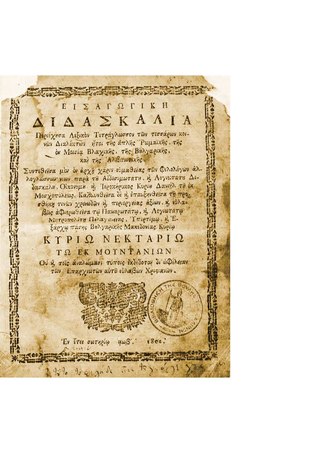
Daniel of Moscopole or Daniil of Moscopole, also known as Mihali Adami Hagi, was an Aromanian scholar from Moscopole and student of Theodoros Kavalliotis, an 18th/19th-century professor and director of New Academy of Moscopole.
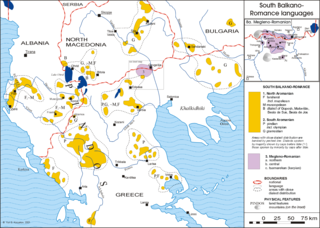
The Aromanian language, also known as Vlach or Macedo-Romanian, is an Eastern Romance language, similar to Megleno-Romanian, Istro-Romanian and Romanian, spoken in Southeastern Europe. Its speakers are called Aromanians or Vlachs. Some scholars, mostly Romanian ones, consider Aromanian a dialect of Romanian.
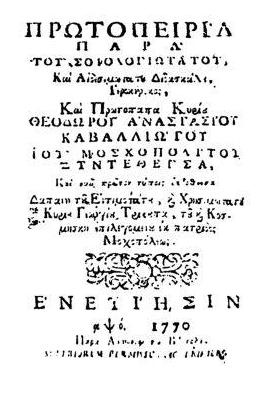
Theodore Anastasios Kavalliotis was a Greek Orthodox priest, teacher and a figure of the Greek Enlightenment. He is also known for having drafted an Aromanian–Greek–Albanian dictionary.
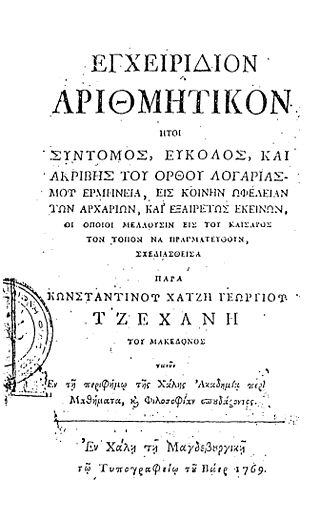
Konstantinos Tzechanis was a philosopher, mathematician and poet from the 18th century Aromanian center of Moscopole.
Ioannis Chalkeus or Chalkias, was an Aromanian scholar, philosopher and figure of the modern Greek Enlightenment.
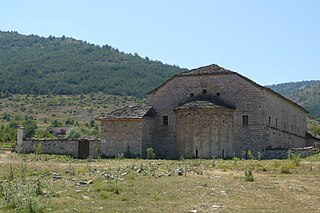
The St. Michael Church (Albanian: Kisha e Shën Mëhillit or Kisha Kryeengjëjt Mihail dhe Gavriil, also known as Church of the Archangels Michael and Gabriel is an Orthodox church in Moscopole, modern southeastern Albania.

The New Academy or Greek Academy was a renowned educational institution, operating from 1743 to 1769 in Moscopole, an 18th-century cultural and commercial metropolis of the Aromanians and leading center of Greek culture in what is now southern Albania. It was nicknamed the "worthiest jewel of the city" and played a very active role in the inception of the modern Greek Enlightenment movement.
Theophrastos Georgiadis was a Greek author and teacher. His work about the once prosperous urban center of Moscopole, today a small mountain village in southeastern Albania, is considered of great value since it concerns the period before the town's destruction in 1916.

Gregory of Durrës was an Albanian scholar, printer, typographer, and teacher, and an Eastern Orthodox Christian monk and cleric of Ottoman Albania who is thought to have invented a particular Albanian alphabetic script, the Elbasan script, used to write the Elbasan Gospel Manuscript. The manuscript is one of the oldest known pieces of Albanian Orthodox literature, as well as the oldest known Orthodox Bible translation into Albanian.
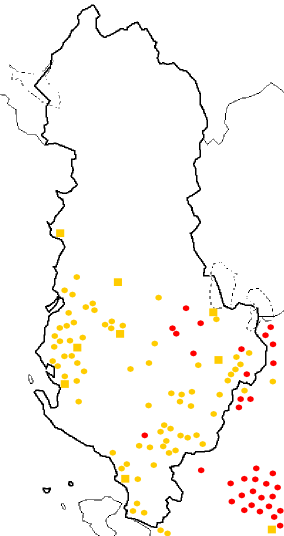
The Aromanians in Albania are an officially recognised ethnic minority in Albania.
The Aromanian diaspora is any ethnically Aromanian population living outside its traditional homeland in the Balkans. The Aromanians are a small Balkan ethnic group living scattered throughout Albania, Bulgaria, Greece, North Macedonia, Romania and Serbia. Historically, they also used to live in other countries such as Bosnia and Herzegovina and Croatia, although they have ever since been assimilated.
Mihail George Boiagi was an Aromanian grammarian and professor in the Habsburg monarchy and the Austrian Empire. He was born on 3 February 1780 in Buda, today Budapest in Hungary. Boiagi was one of the first grammarians from the Balkans and a professor in a school in Vienna, where he taught Greek. He had origins from Moscopole, today in Albania. Boiagi was one of the main figures of the Aromanian diaspora in Austria and Hungary, the capitals of which, Vienna and Budapest respectively, became gathering centers for members of this community in the 19th century. Boiagi introduced the Aromanian historian Dimitrie Cozacovici to the Aromanian community of Austria and Hungary after Cozacovici's migration from Metsovo, today in Greece, to Buda.
Constantin Ucuta was an Aromanian academic and protopope. He was born in Moscopole, an economically powerful city and Aromanian centre at the time then part of the Ottoman Empire and now part of Albania. He migrated to Posen, in Prussia, and entered in contact with the small Aromanian community in the city, mostly composed by merchants. He became an academic and a protopope, serving in a church in Posen most likely erected by the typically Eastern Orthodox Aromanian merchants of the city. Other details about Ucuta's biography are scarce and poorly known.
Nicolae Ianovici was an Aromanian linguist. He is known for the compilation of a dictionary of five languages, including Aromanian. Ianovici was one of the figures of the early Aromanian national movement in Vienna and Budapest.

The Markides Pouliou brothers, Georgios and Poulios, were two typographers in the Habsburg monarchy. They were ethnic Aromanians and were the sons of a merchant from Siatista, with them having also been merchants themselves.











